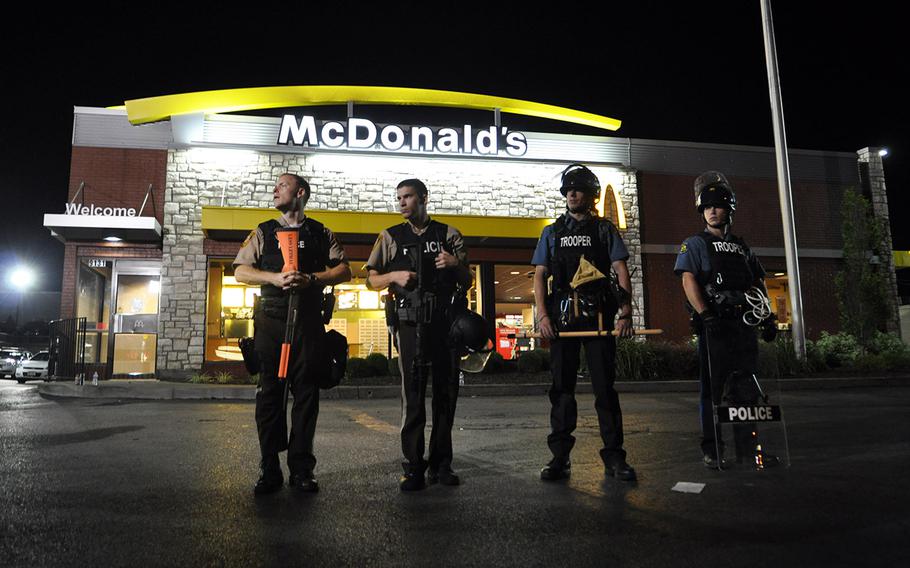
Police in riot gear stand outside a McDonald's in Ferguson, Mo., Tuesday night. Protests over the shooting of a black teen by a white police officer have escalated into riots in the St. Louis suburb and the local authorities' response has sparked a national debate about the militarization of police. (Heath Druzin/Stars and Stripes)
FERGUSON, Mo. — Humvees at the Burger King, smoke grenades in the street, police with assault rifles — just a few of the atypical sights in this small, troubled Midwestern town.
There’s no Taliban, and protesters aren’t planting IEDs. But military uniforms and weaponry used by police and the presence of the National Guard in a suburban confrontation zone seemed more appropriate to military outposts in Afghanistan than a suburb of St. Louis, with its leafy streets and Target Supercenter.
On Thursday, Gov. Jay Nixon ordered the National Guard to begin a “systematic withdrawal” from Ferguson. He didn’t say how soon the withdrawal would be complete and presumably local police armed with Pentagon surplus weapons and battle rattle will remain.
On the eve of Nixon’s order, soldiers in uniform stood guard in a Ferguson mall parking lot serving as a military and police command center.
Some were recently back from Afghanistan, surprised to be called to duty so close to home to help quell riots sparked by a white policeman fatally shooting an unarmed black teen. Shoppers looked on curiously as they strolled by, pushing shopping carts into the Target store.
“It’s odd, but we swore to defend the country against enemies, foreign and domestic,” said a Missouri National Guard sergeant, who declined to give his name because the Guard warned soldiers not to talk to the media.
Another Guardsman said he had served in Iraq “so it’s weird to be called out here.” He spoke before being interrupted by a public affairs officer, who told him he was not allowed to be interviewed.
As in Afghanistan, the military is working hard to manage the message. The Missouri National Guard denied Stars and Stripes an “embed,” the term used for journalists covering military units in Iraq and Afghanistan.
“It’s an unprecedented operation,” said Missouri National Guard spokeswoman Maj. Tammy Spicer.
Managing the messageIt all started with the shooting of Michael Brown. The circumstances remain murky, but his death sparked more than a week of protests, which morphed into violence with looting, a gas station being destroyed and police reporting heavy incoming gunfire Monday. While the chaos has mostly been contained in a half-mile stretch of road, tensions remain high with no end in sight.
The shooting, the riots and the militarized police response in the St. Louis suburb of 21,000 have sparked a national debate about race and police tactics, prompting Attorney General Eric Holder to visit Wednesday.
Mike O’Connell, spokesman for the Missouri Department of Public Safety, said numbers of troops or police officers were not being released.
“We know people are watching,” he said. “If we say we have 100 officers, they will send 100 protesters, etc.”
As of press time, it appeared there were only a few dozen Guardsmen around the command center.
After a Missouri state trooper shouted at a Stripes reporter for taking photos in the parking lot command center, Spicer explained the concern stemmed from threats to the post.
“They’re worried people taking photos could be casing the place for an attack,” she said in a statement that could have easily referred to a base in Afghanistan preparing for an insurgent assault.
Limited missionThe American Civil Liberties Union and others have sharply criticized the state of emergency declared by Missouri Gov. Jay Nixon, which suspends certain constitutional rights, and the call-up of the National Guard.
Nixon called it necessary “to protect the citizens of Ferguson.”
“Given these deliberate, coordinated and intensifying violent attacks on lives and property in Ferguson, I am directing the highly capable men and women of the Missouri National Guard to assist Colonel Ron Replogle and the Unified Command in restoring peace and order to this community,” Nixon’s statement said.
The soldiers have a very limited mission, at least for now. A statement said they are solely there to protect the command center, manned mostly by local and state police who so far are more heavily armed than the troops.
At night, when the protesters have come out in force, the police have shown up in helmets and heavy bulletproof vests more reminiscent of soldiers. Many carried automatic rifles and stood by heavy armored vehicles.
‘Intimidation tactics’Residents of Ferguson have mixed feelings about the presence of uniformed troops, and many expressed dismay at police using military tactics and weaponry. Some said they feared a massacre once the Guard was called, with echoes of the Kent State University shootings of 1970, when National Guard troops opened fire on unarmed protesters, killing four.
“All that show of force is just to have intimidation tactics, and it’s just because they think black people will back down,” said Reggie Harris, 37, a Ferguson resident who has participated in the protests.
A short drive from the protests, the Corner Coffee House seemed a world away, with guests quietly sipping coffee and reading the morning paper — plastered, of course, with coverage of the town.
Chris Shanahan was selling “I Love Ferg” T-shirts to raise money for a local charity and rebuild pride in his town. He said he was deeply upset at seeing soldiers roll into his community, but understood something had to be done.
“I almost cried but I don’t think anyone had an answer,” he said. “How else do you resolve what has been going on?”
Peering out at the protest zone, Ferguson resident Carmelita Williams summed up the feelings of many around the country.
“Here in the United States?! I couldn’t believe it. I guess I didn’t want to believe it.”
druzin.heath@stripes.com Twitter: @Druzin_Stripes